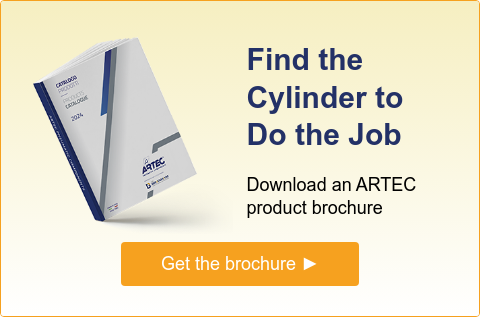Pneumatic Actuators:
A Complete Guide
A pneumatic actuator is a versatile piece of equipment that has many industrial applications and uses.
This guide covers what an actuator is, common types of actuators, how to size an actuator and determine how much force you need, applications for pneumatic cylinders, and advice on repairing them. There is also information on non-air-powered actuators and non-linear types of actuators.
In general, pneumatic actuators are a cost-effective solution any time you have shop air (or a compressed air source) readily available.
Menu
What is an Actuator?
An actuator is a device that makes something move—forward, backward, or at an angle—or rotate to a specified distance or number of degrees. Actuators can also be used to slow, stop, turn, or hold an object depending on which type it is. They work by converting energy from a power source (air, liquid, or electricity) into force.
For example, an elevator goes up and down, but it also has to stop and wait at floors along the way. The doors open and close. In a processing plant, raw materials are conveyed along a complex path where they may be gripped, raised, turned, stamped, rejected, etc. until the final product is complete. Cylinders make all these movements possible. Without them, automated equipment could not exist.
Pneumatic devices, in particular, run off a compressed gas, usually air. Pressurized air is used to control the actuator movement. Whether it is stroking a piston or rotating a disc, the displacement of air drives the load. Pneumatic cylinders are widely popular because compressed air is commonly used for many purposes in industrial settings, so there is often no need for a secondary power source.
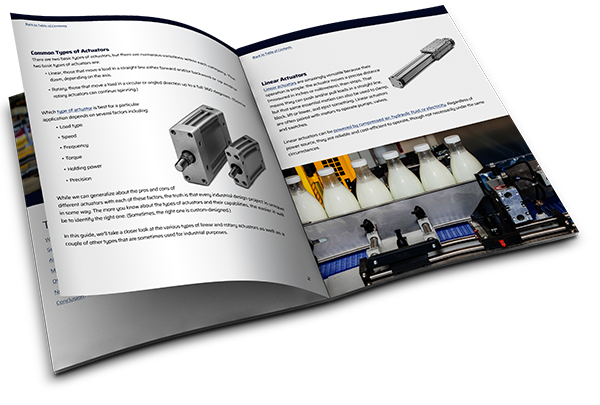
Download the Complete Guide to Air Cylinders
Common Types of Actuators
There are two basic types of actuators, but there are numerous variations within each category. The two basic types of actuators are:
- Linear, those that move a load in a straight line either forward and/or backward or up and/or down, depending on the axis.
- Rotary, those that produce rotational force (torque) to move a load in a circular or arched direction up to a full 360 degrees. (Some rotary actuators can continue spinning).
Which type of actuator is best for a particular application depends on several factors including:
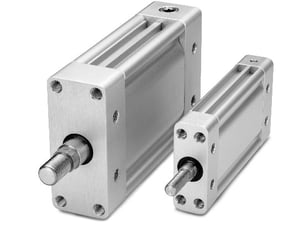
- Required motion
- Load type
- Speed
- Frequency
- Torque
- Holding power
- Precision
While we can generalize about the pros and cons of different actuators with each of these factors, the truth is that every industrial design project is unique in some way. The more you know about the types of actuators and their capabilities, the easier it will be to identify the right one (sometimes, the right one is custom-designed).
In this guide, we’ll take a closer look at the various types of linear and rotary actuators as well as a couple of other types that are sometimes used for industrial purposes.
Linear Actuators

Linear actuators are amazingly versatile because their operation is simple: the actuator moves a precise distance (measured in inches or millimeters), then stops. That means they can push and/or pull loads in a straight line, but that same essential motion can also be used to clamp, block, lift or lower, and eject something. Linear actuators are often paired with motors to operate pumps, valves, and switches.
Linear actuators can be powered by compressed air, hydraulic fluid, or electricity. Regardless of power source, they are reliable and cost-efficient to operate, though not necessarily under the same circumstances.
Rotary Actuators
Where linear actuators can move loads only in a straight line, rotary actuators can move them at virtually any angle or provide continuous spinning. Picture a conveyor with a swing gate that pivots into position to divert an item onto another conveyor, into a box, etc. Or an arm that lifts and turns the item onto its side as it moves forward.
Rotary actuators are often used in conjunction with linear actuators. They can be powered by either compressed air or hydraulic fluid systems.
Selecting the Right Pneumatic Linear Actuator
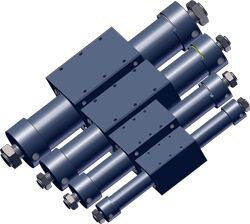
Under the pneumatic linear actuator umbrella, you’ll find rodded and rodless, the latter which can be broken down into cable, band, and magnetically-coupled.
All of these can be single- or double-acting. Single-acting actuators work in one direction only. The actuator piston is extended forward, then an internal spring, load force, or simple gravity retracts it to the original position. In a double-acting cylinder, air pressure is used to move the piston (and, therefore, the load) in both directions. There are many industrial uses for double-acting cylinders.
Let’s take a closer look at the different variations of pneumatic linear actuators:
- Rodded Pneumatic Linear Actuator: In this type of actuator, there is an internal rod, which extends outside the cylinder to move the load forward and then retracts. Typically, the rod and the bore are round. However, W.C. Branham makes a unique oval-bore version called OVLPRO®. This design eliminates any chance the rod will become misaligned over time as it extends and retracts.
This video explains how to select the right size OVLPRO® cylinder for an application.
-
Rodless Pneumatic Cable Actuator: As the name implies, cable-driven actuators use an internal cable instead of a rod to move the load. The cable fastens to the piston inside the cylinder but also extends outside, where it attaches to a pulley. Cable actuators are very efficient and function well where high repeatability is needed. They can also work with spring assist for emergency stopping. As with all types of actuators, correctly sizing the device is essential.
This video explains how to size and determine the amount of force you need.
- Rodless Pneumatic Band Actuator: Rodless band cylinders are a good choice where space is very limited because there is no rod to protrude from the cylinder as it extends. W.C. Branham’s DURATRK® rodless cylinders can provide the same amount of force in about 45% less space. They can be spec’d in multiple bore sizes and lengths, as explained in this video.
- Rodless Pneumatic Magnetically-Coupled Actuator: This style of actuator uses magnets instead of physical attachments to draw and retract the piston within the cylinder. The piston is sealed within a tube, which attaches to a carrier using magnetic force so that the piston and carrier move together as one. Magnetically-coupled cylinders are very powerful. They can be sized to move loads a very short distance or several feet. Because the piston is sealed inside, there is no danger of damage from external dirt, corrosive materials, or other harsh elements. This also means these cylinders can function while submerged.
This video explains how to determine how much force a magnetically-coupled cylinder requires.
Pneumatic Cylinder Applications
Pneumatic linear actuators are ideal for applications that require strength/high torque and speed but need a lightweight product. They can withstand temperature extremes from 250 degrees Fahrenheit to -40 degrees Fahrenheit as well as wet or harsh environments. They can be made of stainless steel to meet extreme standards such as those for food and beverage processing or semiconductor clean rooms. They are also a good choice for environments where safety may be a special concern because there are no motors to generate magnetic interference that could cause an explosion.

With pneumatic actuators, there are no worries about contamination from leaking hydraulic fluid, which makes them an excellent choice for car washes as well as production plants.
They can streamline material handling when tasks involve a complex series of movements such as multiple starts and stops, high speeds, or changing speeds. Although all pneumatic linear actuators can provide precise movement, they can also be fitted with positioning sensors when even greater precision is needed. Branham’s oval bore models are especially valuable where precision is critical such as in medical device manufacturing.
Pneumatic actuators are available in a wide range of sizes, styles, and configurations, can be used with a variety of mounts, and require minimal maintenance.
Maintaining and Repairing Cylinders
Even cylinders built to last will eventually either wear out or need to be repaired. That’s the nature of equipment performing in high-stress, multi-cyclic environments. There are things you can do to make your pneumatic cylinders last longer, like inspecting them regularly and cleaning external parts. You will know something is wrong if you notice leaking seals, erratic movement, drift, or slower-than-normal operation.
Another way to lengthen the life of an actuator is to make sure it is set up correctly at the time of installation. For example, with a cable cylinder, you must proof-load and pre-tension the cable.
This video explains how to do it on W.C. Branham’s cable cylinders.
Featured Pneumatic Actuator Product Lines
ARTEC®
Pneumatic actuators, like most other manufactured components, follow a set of sizing and configuration standards. In the United States, most cylinders follow the imperial NFPA (National Fluid Power Association) standard, while Europe follows the metric International Standard for Standardization (ISO).
In 2022, Branham partnered with the European company ARTEC® to distribute several types of ISO cylinders. Artec delivers top-of-the-line performance with its short-stroke and compact ISO-certified cylinders. Some options include:
Crafted with precision and reliability in mind, these cylinders feature high-quality seals that prevent leakage and safeguard internal components from contaminants. This is vital as seals ensure proper pressure within the cylinder, which prevents leakage and protects the internal cylinder components from outside contaminants.
Procuring high-quality manufacturing components is becoming nearly impossible without also conceding to lengthy lead times. Distributors and OEMs sometimes feel that they must choose between first-rate products and getting those products in a reasonable enough time to satisfy their own customers and partnerships. Artec—a pioneer in the actuator manufacturing game–gives you both. Interested in how your pneumatic cylinders match up with Artec products? Check this pneumatic cylinder cross-reference guide to compare Artec cylinder models against competitor products.
ULTRIQTM
Modern equipment design increasingly demands compact components without sacrificing performance. This is particularly true in pneumatic system design, where space constraints often challenge traditional cylinder configurations.
But what constitutes “compact” depends on your design. Sometimes you need different shapes and smaller sizes, and that’s where Branham’s ULTRIQTM compact pancake cylinders excel.
- ULTRIQTM cylinders are low-profile pneumatic actuators designed for applications with limited space but high force requirements.
- Using a large bore size with a short stroke length, these cylinders deliver powerful torque in a compact form factor.
- They're well-suited for manufacturing, material handling, packaging equipment, automated assembly, robotics, low-profile clamping, and precision applications in automotive, electronics, and medical devices.
ULTRIQ™ cylinders follow the imperial NFPA standard and are available in five bore sizes and 13 stroke lengths. These cylinders feature upgraded Quad-X ring seals and thick-walled aluminum construction for durability and long-term reliability
.
Other Power Sources for Actuators
Pneumatic cylinders are common because many facilities already have airpower systems in place. However, there are other power options beyond airpower, including hydraulic and electric.
Hydraulic Linear Actuators
Linear actuators that use hydraulic fluid can generate a tremendous amount of force and hold it almost indefinitely because fluid is virtually incompressible. A hydraulic actuator can produce 25 times more force than a similarly sized pneumatic actuator. However, hydraulic power can also perform subtly because that same fluid incompressibility allows for precise linear control.
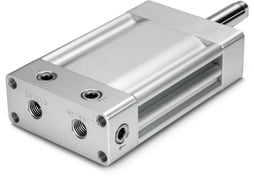
Not only can a hydraulic actuator dish out the force, but it can also stand up to shock loads as well as dirty or otherwise harsh working conditions. Like their pneumatic cousins, hydraulic linear actuators can be single- or double-acting.
- Hydraulic Rod Linear: It takes a lot of force to move, control, and hold the heaviest loads, and that’s where hydraulic rod actuators shine. Think elevator operation or a car carrier that has to lift and lower automobiles. Rod-style hydraulic cylinders can exert up to 5,000 psi (compared to a similar-sized pneumatic actuator that would provide just 100-200 psi).
- Hydraulic Cable Linear: A cable-style hydraulic actuator under low pressure can provide very smooth movement.
Hydraulic Actuator Applications
Hydraulic linear actuators are useful in a broad array of applications, especially in various forms of material handling. They can move loads forward and back, clamp, press, lift, turn, and rotate items. They can stop loads and ensure a no-fail hold. They are tough, reliable, and can be configured in many different ways to enable standardized equipment design. Perhaps surprisingly, hydraulic actuators can be quite compact and still deliver high-force performance.
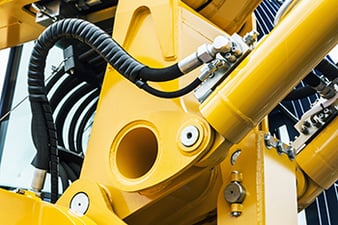
You might think of them as the tortoise and pneumatic actuators as the more nimble hare.
Hydraulic systems can be self-contained, enabling mobility. This is why heavy-duty construction and shipyard equipment, forklifts, etc. use hydraulic actuators. In static manufacturing facilities, the system’s motor and pump can be located some distance away without sacrificing power.
Hydraulic systems require more maintenance than other types of actuators because there are more moving parts. Seals wear out and have to be replaced, and the potential of leaking fluid makes hydraulic cylinders inappropriate for applications where sanitation is critical such as clean rooms, food processing, and beauty product manufacturing.
Electric Linear Actuators
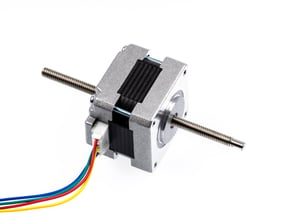
Electric actuators use a motor as their power source, so the process is somewhat more complex. In most pneumatic and hydraulic actuators, pressure moves a piston that moves the load. In an electric actuator, there is no piston, there is either a screw or a belt (similar to the cable in other actuators). The electric motor activates gears, which turn the screw or drive the belt to move the load. That means the motor must be an integral part of the actuator set-up, which requires more space.
On the other hand, electricity is universally available, whereas compressed air or hydraulic fluid systems may not be.
Electric actuators are more expensive to buy than other types, but they are less expensive to operate. They can be used alone or grouped to perform multiple tasks in sequence such as reaching, lifting, tilting, or rotating. Both screw-driven and belt-driven electric linear actuators can provide high-speed, precise, repeatable position control. And they are strong. They can generate force between 2,000 and 4,000 pounds.
- Electric Belt Actuators: Electric actuators that use a timing belt are 90% efficient, easy to operate, and long-lasting.
- Electric Screwdriver Actuators: Electric linear actuators that use a screwdriver are especially useful for high-thrust applications where accuracy and repeatability are essential.
Electric Actuator Applications
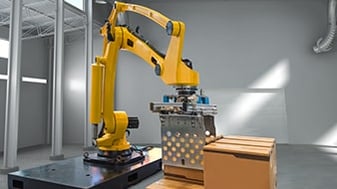
Electricity is infinitely scalable and controllable, so electric linear actuators are a great choice for applications that require extreme precision. They can also be programmed electronically for remote operation. Due to their motorized operation, they are best for situations that require only a few cylinders. However, they are very versatile, making them valuable for tasks such as material handling, robotics, operating cutting equipment, positioning solar panels, raising and lowering heavy, hard-to-reach windows, and opening and closing valves.
Electric linear actuators are completely sealed, so they are clean to operate. That makes them a good choice for sanitary environments such as the manufacturing of medical devices, semiconductors, and for food and beverage processing—applications where the process itself has to be pristine and where equipment is also subjected to harsh water and chemical washdown treatment.
Conclusion
Because actuators go to the heart of the job, it can be virtually impossible (or impossibly expensive) to change them out once equipment is installed. That makes it all the more imperative that you make the right choices to begin with.
W.C. Branham manufactures several styles of pneumatic actuators, including our exclusive oval-bore model, as well as some types of hydraulic cylinders. All are available in numerous sizes and configurations. We’ve been in business for many years helping companies and design engineers find “solutions in motion” that exactly fit their needs. Visit our product page to learn more.
One thing we know for sure is that no two projects are the same. That’s why we don’t simply make and sell actuators, we provide as much advice and as many recommendations as you need. We are always happy to modify or completely custom-design a product.


